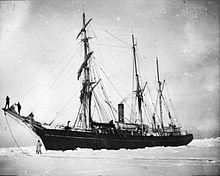Nimrod (ship)

The Nimrod was originally a for the purpose of hunting of seals made saver with a standard displacement of 334 tons . It was built in 1865/6 by Alexander Stephens & Son in Dundee from oak, green heart and iron bark wood . The ship was commissioned by Job Brothers, a Liverpool-based whale and seal fishing company , but the home port of Nimrod was St. Johns , Newfoundland . When it was built, the ship had a two-cylinder steam engine with a nominal output of 60 hp at the Westray Copeland & Company shipyard in Barrow-In-Furness .
Ernest Shackleton bought the ship in 1907 for his first own Antarctic expedition for £ 5,000. He had it converted into a schooner bark with square sails on foremast and gaff sails on main and mizzenmast in the shipyard of R. & H. Green in Blackwall Yard in London's East End . In addition, the Nimrod received an engine with a nominal 60 hp, with the help of which it reached 6 knots under steam and consumed four tons of coal a day in calm weather.
After completing the expedition and returning to Great Britain, the Nimrod initially served as a museum ship , but was then sold to cover part of the cost of the Nimrod expedition. On January 31, 1919, the ship came to an end when it ran off the coast of Norfolk on the cliffs of Barber Sands and sank. Only two men of the twelve-man crew survived.
The Nimrod is the namesake for the Antarctic mountain Mount Nimrod .
literature
- Lloyd's Register of British and foreign Shipping, Vol. I, 1897, London
